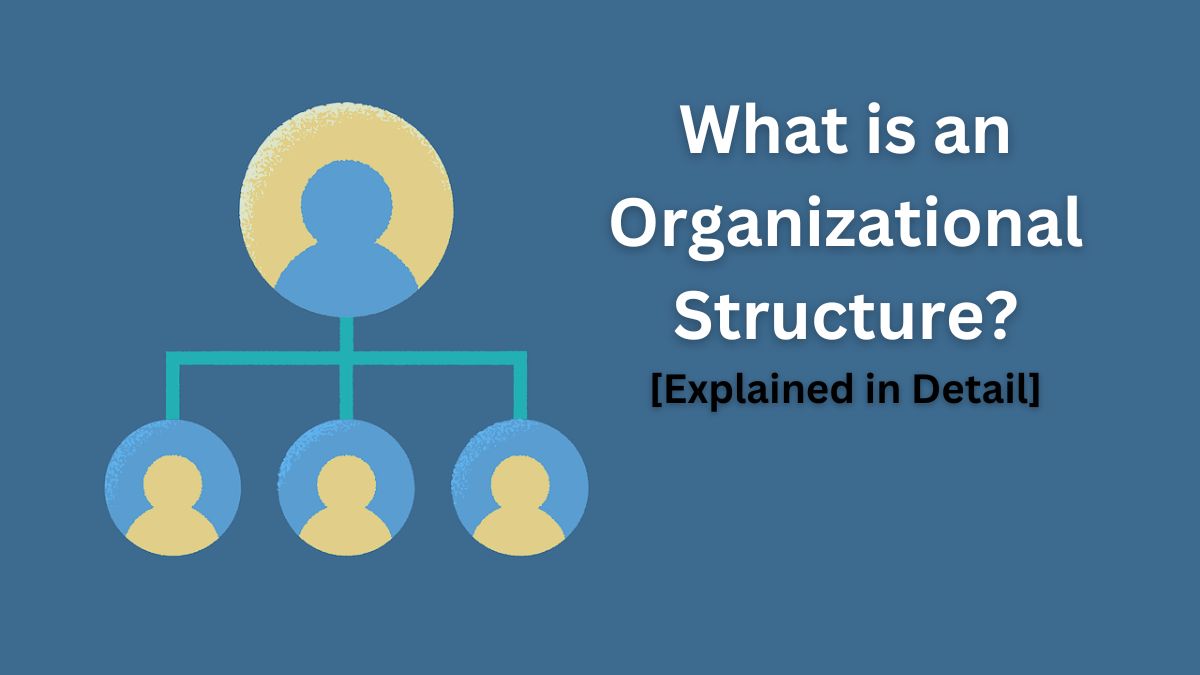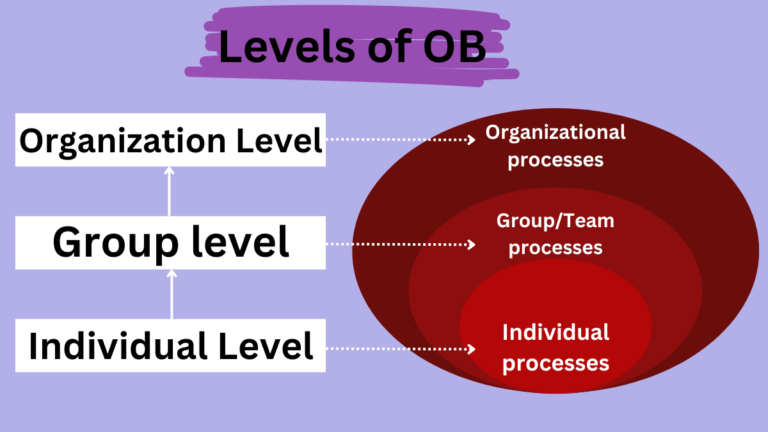What is an Organizational Structure? Definition, Objectives, Components, Types, and Importance
Every organization’s success or failure is directly proportionate to how its activities are managed. How organizational activities are directed toward the achievement of organizational goals determines whether or not the goals will be achieved. The process of outlining how the activities should work is considered an organizational structure. Let’s understand it in detail.
What is an Organizational Structure?
An organizational structure is a system that clearly outlines how certain activities should be done in order to achieve the desired organizational goals and objectives. It outlines how rules, roles, and responsibilities should be distributed among team members and directed to achieve the desired goals.
The development of the organizational structures defines the authority-responsibility relationship in the organization. Defines how information should be communicated, who is superior, who is subordinate, who should command to whom, who should report to whom, etc.
It clarifies each employee’s role in it and how his role interacts with the whole system. In more simple words, the organizational structure is a map that simply explains how the organization works and its activities to accomplish its targets.
Centralization and decentralization are the two main bases for creating organizational structures. In a centralized organizational structure, the decision-making authority is vested in the top manager only and decisions flow from the top to bottom. Whereas, in decentralized organizational structures, the decision-making rights are distributed among different levels of managers.
What is the Objective of Creating an Organizational Structure?
The following are the main objectives for creating organizational structures.
- Ensure proper integration of rules, roles, and responsibilities among all organizational members.
- Establish a clear authority-responsibility relationship.
- Develop a system of work accomplishment.
- To increase organizational efficiency and effectiveness.
- To ensure effective and efficient goal achievement.
- To reduce role ambiguity among employees.
Elements of Organizational Structure
The following five are the main components that should be included in creating an organizational structure.
Job Design
Job design is the primary function of the organizational structure. The process of figuring out a person’s duties at work is called job design. It is the technique of logically breaking down a difficult task into manageable parts.
Related: What is Organizing?
Employees are only held accountable for a select group of tasks as a result. The main benefit of work design is that it promotes employee specialization, which ultimately promotes maximum productivity.
Departmentalization
Departmentation is the process of organizing tasks of a similar kind into controllable groups known as units or departments to make each task easier to complete. It divides related jobs into various functional units for the proper coordination of organizational resources.
Delegation of Authority
The management concept of delegation of authority entails a manager or superior giving a subordinate in the chain of command work, responsibilities as well as decision-making rights, or authority.
Simply said, this is the act of allowing subordinates to exercise managerial power while performing their duties. It contains a structured procedure for delegating authority from the superior to the suitably qualified subordinates so they can decide how best to use resources as needed.
Chain of Command
The chain of command in an organization refers to the distinct and visible division of authority between the various job positions. It makes it clear who is in charge and to whom each person should answer.
The unity of command and scalar chain are the main components of the chain of command. Where unity of command states there should of provision for an employee to work under and report to only one boss at a time.
Whereas, the scalar chain states an unbroken line of authority from the top to the bottom following which the information should be passed.
Span of Control
The span of control refers to the total number of subordinates that a single manager controls or manages. The smaller the number of subordinates a manager controls, the smaller his span of control will be.
In organizational structure, the span of control needs to be balanced. Meaning that a manager should have a manageable number of subordinates otherwise the manager’s productivity will be disturbed.
Read Also: Organizational Change
Types of Organizational Structure
Depending upon the size and nature of the business organizational structures vary from organization to organization. However, effective organizational structures are desirable for productivity and increased performance.
Each organizational structure has its advantages and disadvantages. There are several types of organizational structures some of which the common types are mentioned below:
Line Structure
Line structure is one of the simplest and oldest organizational structures. This organizational structure provides a clear division of authority and responsibility. In this line of organization, authority flows from the top to the bottom and responsibility from the bottom to the top level.
It is also known as a military organization as it was first developed and used by the military. In line structure, each superior is independent in making decisions and each subordinate is directly responsible to his superior.
Flat or Horizontal Structure
A flat or horizontal organizational structure is a structure with only a few or no levels of management between senior and staff-level employees. In order to remove the demerits of line structure like a lengthy scalar chain, the possibility of decision delay, and poor employee satisfaction, the flat structure is brought into practice.
In a flat organization, there will be close supervision of the employees which facilitates higher productivity, strong belongingness, and facility for quick decisions.
Functional Structure
In a functional structure, the whole task of the organization is divided according to the type of work involved. It gives more emphasis on specialization. Different external experts are appointed as departmental managers to operate departmental activities.
A functional specialist formulates plans and policies for his departments and implements them in the practical field. For example, the engineering department would be staffed with software engineers.
Multidivisional Structure
It is the organizational structure in which a firm is divided into different product divisions. Each division is responsible for carrying out functions in a distinct business area. In this structure, each division has some decentralized authority and is held accountable for its performance.
General Electric is an example of a company that uses this structure. Its main goal is to maximize overall organizational performance.
Geographic Structure
Geographic structure, as its name suggests, is the concept of developing organizational structure based on the geographical locations of any business organization. This structure is suitable when the organization has its business expanded into different geographic areas.
Matrix Structure
A matrix structure is a type of organizational structure that promotes the horizontal exchange of knowledge and skills. It is mostly utilized in the administration of major projects or the process of developing new products, bringing together individuals from several functional disciplines for team assignments without removing them from their current roles.
This indicates that individuals with various backgrounds and areas of expertise from various departments make up the matrix structure.
Work Team Structure
Three types of team organizational structures i.e. project team, task force team, and venture team are commonly used in the organization.
- Project Team – A project is any mission that needs to be accomplished or solved within the time limits and standard quality. In order to accomplish the project work, a team of various specialists is established.
- Task Force Team – It is a group of top executives and specialists from different functional areas of the organization. Such teams are prepared to solve any specific problem or to initiate a new venture.
- Venture Team – For introducing new ventures, products, or new business venture teams are created in the organization.
Network Structure
The network structure is comparatively a newer organizational structure which is viewed as less hierarchal, more decentralized, and more flexible than other structures. In this structure, managers coordinate, and control relations that are both internal and external to the organization. It is based on the social network of interactions.
360 Degree Structure
The 360 degree is a new way of thinking which elaborates on the effectiveness of team structure. Under this structure, each manager takes responsibility, accountability, and decision-making authority.
Each member shares ideas, views, and feedback with each member under the structure so that cooperation, coordination, and mutual understanding can be increased. Each member gets a professional opportunity given to coworkers to provide 360-degree feedback about the performance of their fellow employees.
Read Also: The 14 Principles of Management
Importance of Organizational Structure
Putting the right organizational structure in the workplace assists each member of the firm to do better. It not only outlines the ways explaining how the work should be done but also provides the necessary power to employees to make decisions on their end by means of its different types (that we have discussed above).
This facilitates timely and efficient work done in the organizations. The business can carry out many operations simultaneously by dividing workers and tasks into distinct departments and granting the required autonomy.
The points that justify the importance of creating clear organizational structures can be pointed out below:
- Reduces role ambiguity.
- Offers clarity in roles and responsibilities.
- Ensures effective communication.
- More efficient and much more effective operations.
- Ensures proper coordination.
- Clear hierarchal structure.
- Growth and expansion.
- Productivity and enhanced performance.
- Ensures timely goal achievement.
Mechanistic Vs. Organic Views on Organizational Structures
In the practice of management, there are mainly two views on organizational structure, one is the mechanistic view and another is the organic view. They are explained below:
Mechanistic View
Mechanistic is the most traditional view of the organization many classical theorists represent this view. According to mechanistic structure, an organization is a machine that converts input into output through certain processes. Under this, the working of the organization is quite rigid.
The mechanistic perspective assumes that organizations operate in a stable and predictable environment. It states the prime goal of the organization should be increasing efficiency through specialization and standardization of work.
Organic View
This is the modern view of the organization. The organic view emphasizes the socio-psychological aspects of human beings in organizations. Managers should analyze socio-psychological aspects to motivate employees. The organic organizational structure views organizations as living, changing, and constantly adapting to the environment.
Read Next: Organizational Development
Sajan Kushmi is a content writer with more than 4 years of experience. He holds BIM Degree. He write on the topics related to Management, Marketing, and Entrepreneurship.






